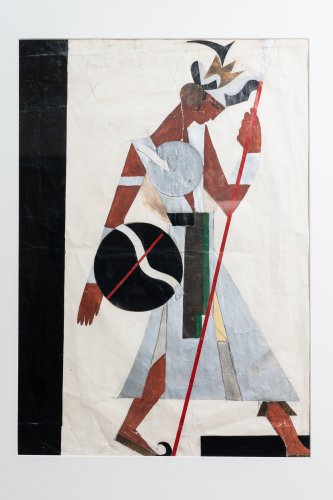Anatol Petrytskyi. Sketch of the Warrior’s costume for the play Nur and Anitra (1923)
Before you is a Sketch of the Warrior's costume for the play Nur and Anitra. Its author, Anatol Petrytskyi, is a representative of the Ukrainian avant-garde, who managed to combine the roles of scenographer and painter. However, Petrytskyi himself often lamented that the work of a stage designer is not appreciated — hundreds of sketches are destroyed. "A great work of painting and a great work in the theater are equivalent," the artist was convinced.
Sketch of the Warrior's costume for the play Nur and Anitra by Anatol Petrytskyi (1923)
And although Anatol Petrytskyi's name is most associated with the stage today, his legacy also includes paintings that were exhibited at major exhibitions in Western Europe during the artist's lifetime, including at the Venice Biennale in 1930. A series of one hundred pictorial portraits of Ukrainian artists, including Pavlo Tychyna, Mykhailo Semenko, Ivan Dniprovskyi, Pavlo Usenko, Tadeusz Dolenga-Mostovych, director Vasyl Vasylko, is notable. Only 19 portraits "survived" the struggle of the communist regime with “formalism".
As a scenographer, Petrytskyi opened up in cooperation with Les Kurbas at the Young Theater in Kyiv in the late 1910s. They met in the Kyiv cafe H.L.A.M. (the abbreviation of words Artists, Literators, Painters, Musicians in Ukrainian), which at that time was a place of attraction for extraordinary, talented personalities. Petrytskyi and Kurbas were close friends, but they also argued a lot about their views on life and art. In the series of portraits created by Petrytskyi, one dedicated to Kurbas has been preserved. Surrounded by books, the director is depicted as sad and dreamy, as if his real friends are books.
After a successful debut at the Youth Theater in Kyiv, Anatol Petrytskyi worked with almost the entire repertoire of the theater at that time as a stage and costume designer. Later, he worked in many theaters in Kyiv and Kharkiv, Moscow, received an invitation to stay at the Bolshoi Theater, but refused.
The sketch from the collection of the Mystetskyi Arsenal was created by Anatol Petrytskyi in Moscow in 1923 for the performance Nur and Anitra by the Mordkin Ballet. All preparations for the play were developed back in the period when the political situation in the Soviet Union allowed for experimentation and showing the works of the artist's and director's imagination from the stage without censorship.
The figure of a young warrior in white clothing depicted in the profile is extremely dynamic, even tense. On the head is an outfit similar to a shako, which seems to move from left to right. Important attributes of the costume: thin spear, black shield with white and red stripes.
The avant-garde nature of the drawing is clearly visible — the man's figure consists of seemingly separate geometric shapes: triangles, trapezoids, circles — but it does not look fragmented. The composition remains unified and complete, and the person is completely recognizable. Petrytskyi seems to destroy the usual image and reassemble it from the fragments.
Sketch of the Warrior's costume for the play Nur and Anitra by Anatol Petrytskyi was animated by Pause to Play animation studio.
Created as part of the Living Collection project
Both in this and in other works of Petrytskyi, love for colors and flatness can be seen. Many remember how freely the artist worked with a line that seemed to go in the right direction by itself; often did not even prepare sketches, but immediately moved on to work with materials, final design of scenery. Perhaps these skills are the result of early influences on the artist. As a young man, he admired the works of Titian, later immersed himself in the study of Ukrainian folk motifs; was influenced by the public debate about the Impressionists. Petrytskyi criticized the realists, movement, dry academicism of the Kyiv Art School (where he constantly tried to rebel and, in the end, from which he was expelled). But there he managed to learn from the best masters of the institution: Murashko, the Krychevsky brothers, Boychuk and Ekster.
Despite the success and recognition, Anatoly Petrytskyi's path to painting and, ultimately, to the theater was rather winding. He passed through the Kyiv boarding school for children of railway workers, where the boy was given by his father due to lack of other options. In addition to the profession of a railway worker, young Anatol had the opportunity to hope for something better. However, it was at this time that his interest in the theater manifested itself. In the boarding house, Anatol organized his own theater, where he played the role of a director, actor and artist, and negotiated with the administration about performances. Although he received only three in drawing at the boarding school, after graduation, instead of working at the Kyiv railway or the acting faculty, Petrytskyi entered the Kyiv art school.
The entire work of the artist can be conditionally divided into two periods. The first, typically avant-garde, was a time of searching and expanding horizons. The second became, on the contrary, a period of restriction and adaptation to the communist regime after accusations of formalism. Such a change was literally vitally necessary, because in 1937 Petrytsky was on the verge of being shot. His salvation was his worldwide recognition.
